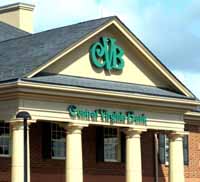Not to be outdone by a major announcement from its largest local rival, C&F Bank and its parent company announced a deal of its own late Monday to acquire Powhatan-based Central Virginia Bank.
Headquartered in West Point, Va., C&F will pay $855,000 in cash or $0.32 per share to acquire CVB and its holding company, Central Virginia Bankshares. C&F said it will also pay $3.35 million to redeem the preferred stock and common stock warrants CVB had yet to buy back from the U.S. Treasury as part of the TARP Capital Purchase Program.
The deal would bring C&F’s total assets to $1.35 billion.
A $387 million bank, CVB ran into trouble after it lost a combined $33 million between 2008 and 2010 due to losses on investments in Lehman Brothers, Fannie Mae and Freddie Mac, as well as on soured commercial real estate and business loans.
Regaining large-scale growth and high levels of profitability has been a struggle ever since.
CVB was forced into a written agreement with its regulators in June 2010. That agreement was designed to stave off diminishing capital levels and get problem loans in check.
Veteran banker Herb Marth was brought on as a turnaround specialist that year. He was named permanent president and chief executive in January 2011, replacing longtime chief Larry Lyons.
The bank got back in the black in 2011 and was able to improve its capital levels. But much of its revenue growth has relied on investment income, and it fell back to a slight loss in the first quarter of 2013 and has continued to shrink its balance sheet in an effort to minimize risk and maintain capital.
Marth, aware of the bank’s difficult situation, said in CVB’s recent first quarter earnings release that it faces continued challenges.
“Producing income in 2013 has become more challenging for us than in the previous two years, when we were able to harvest significant gains in our investment portfolio,” he said in the release.
The bank has also struggled to deal with its TARP burden. CVB received $11.4 million through the program and hasn’t had the cash or the ability to raise capital to buy its way out. And its written agreement has prohibited the bank from paying dividends of any kind, including on TARP shares, a tally that has added up to an extra $1.9 million.
“While [TARP] helped CVB weather the storm, paying off TARP has become problematic for us and many other community banks in the U.S.,” Marth said in the earnings release last month. “We do not expect to be in a position to declare or pay our TARP dividends in the foreseeable future. Capital market options continue to be limited or nonexistent for banks with our profile, and raising additional capital to help with our TARP situation has not been viable. Therefore we continue to evaluate and pursue all of our strategic alternatives.”
C&F was one of only a few local banks to remain profitable throughout the recession. It was also one of the first local banks to buy its way out of the TARP program.
It reported a profit of $4 million in the first quarter of 2013. That followed a $16 million profit for the year in 2012.
C&F will add CVB’s seven branches to its 18 locations.
Larry Dillon, C&F’s chairman, president and chief executive, will remain at the helm once the companies are combined.
Marth will become a senior banking executive at C&F and will join its Richmond board.
“We are confident that partnering with C&F will provide the most positive outcome for CVB’s customers, employees and shareholders,” he said in the company’s joint release Monday.
The acquisition has been approved by the boards of directors of both companies, they said in their release. The transaction is expected to close in the fourth quarter of 2013, pending regulatory approvals and approval of CVB’s shareholders.
Correction: A previous version of this story incorrectly stated that C&F has 25 branch locations. It currently has 18 branches and would have 25 after adding CVB’s seven locations.
Not to be outdone by a major announcement from its largest local rival, C&F Bank and its parent company announced a deal of its own late Monday to acquire Powhatan-based Central Virginia Bank.
Headquartered in West Point, Va., C&F will pay $855,000 in cash or $0.32 per share to acquire CVB and its holding company, Central Virginia Bankshares. C&F said it will also pay $3.35 million to redeem the preferred stock and common stock warrants CVB had yet to buy back from the U.S. Treasury as part of the TARP Capital Purchase Program.
The deal would bring C&F’s total assets to $1.35 billion.
A $387 million bank, CVB ran into trouble after it lost a combined $33 million between 2008 and 2010 due to losses on investments in Lehman Brothers, Fannie Mae and Freddie Mac, as well as on soured commercial real estate and business loans.
Regaining large-scale growth and high levels of profitability has been a struggle ever since.
CVB was forced into a written agreement with its regulators in June 2010. That agreement was designed to stave off diminishing capital levels and get problem loans in check.
Veteran banker Herb Marth was brought on as a turnaround specialist that year. He was named permanent president and chief executive in January 2011, replacing longtime chief Larry Lyons.
The bank got back in the black in 2011 and was able to improve its capital levels. But much of its revenue growth has relied on investment income, and it fell back to a slight loss in the first quarter of 2013 and has continued to shrink its balance sheet in an effort to minimize risk and maintain capital.
Marth, aware of the bank’s difficult situation, said in CVB’s recent first quarter earnings release that it faces continued challenges.
“Producing income in 2013 has become more challenging for us than in the previous two years, when we were able to harvest significant gains in our investment portfolio,” he said in the release.
The bank has also struggled to deal with its TARP burden. CVB received $11.4 million through the program and hasn’t had the cash or the ability to raise capital to buy its way out. And its written agreement has prohibited the bank from paying dividends of any kind, including on TARP shares, a tally that has added up to an extra $1.9 million.
“While [TARP] helped CVB weather the storm, paying off TARP has become problematic for us and many other community banks in the U.S.,” Marth said in the earnings release last month. “We do not expect to be in a position to declare or pay our TARP dividends in the foreseeable future. Capital market options continue to be limited or nonexistent for banks with our profile, and raising additional capital to help with our TARP situation has not been viable. Therefore we continue to evaluate and pursue all of our strategic alternatives.”
C&F was one of only a few local banks to remain profitable throughout the recession. It was also one of the first local banks to buy its way out of the TARP program.
It reported a profit of $4 million in the first quarter of 2013. That followed a $16 million profit for the year in 2012.
C&F will add CVB’s seven branches to its 18 locations.
Larry Dillon, C&F’s chairman, president and chief executive, will remain at the helm once the companies are combined.
Marth will become a senior banking executive at C&F and will join its Richmond board.
“We are confident that partnering with C&F will provide the most positive outcome for CVB’s customers, employees and shareholders,” he said in the company’s joint release Monday.
The acquisition has been approved by the boards of directors of both companies, they said in their release. The transaction is expected to close in the fourth quarter of 2013, pending regulatory approvals and approval of CVB’s shareholders.
Correction: A previous version of this story incorrectly stated that C&F has 25 branch locations. It currently has 18 branches and would have 25 after adding CVB’s seven locations.

